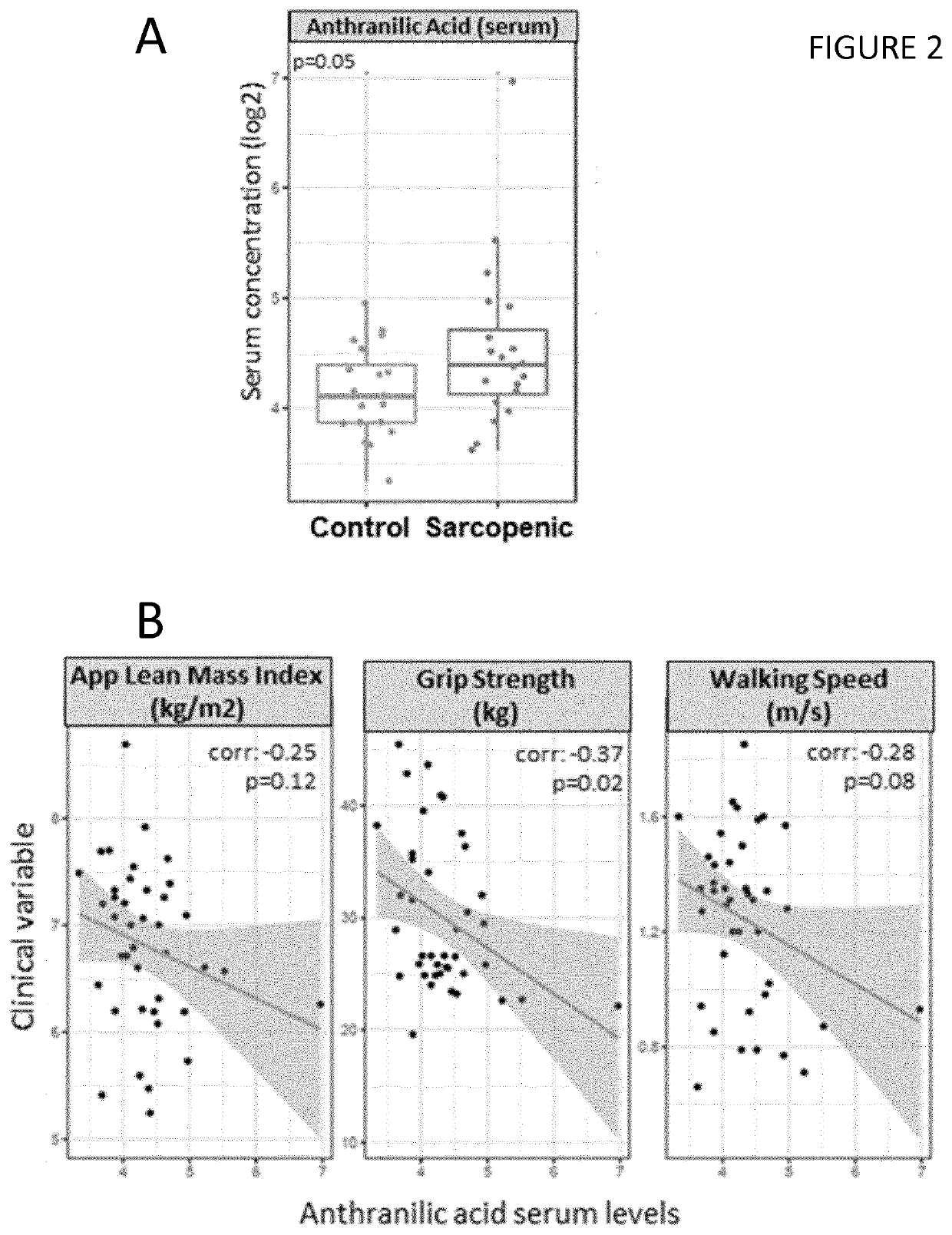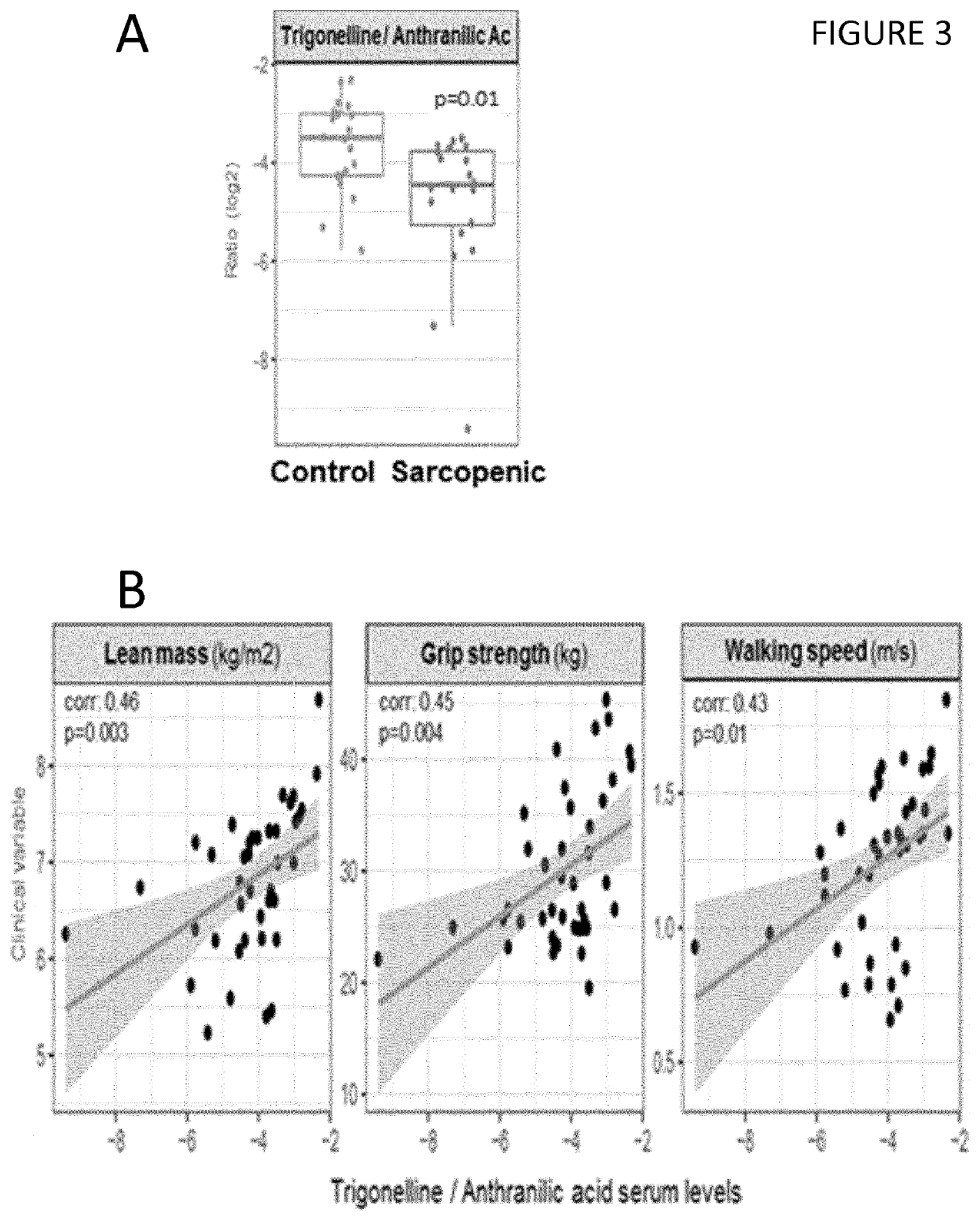Methods to predict risk of and to stratify sarcopenia and nad deficiency
a technology of sarcopenia and risk stratification, applied in the direction of instruments, drug compositions, plant/algae/fungi/lichens ingredients, etc., can solve the problem of substantial health care cost attributable to sarcopenia
- Summary
- Abstract
- Description
- Claims
- Application Information
AI Technical Summary
Benefits of technology
Problems solved by technology
Method used
Image
Examples
example 1
Metabolite Measurements in Serum
[0142]Twenty male participants of predominantly Chinese descent aged 65-79 years and 20 control subjects of the same age group without a diagnosis of sarcopenia were recruited from 2 studies on healthy community-dwelling older men in Singapore (Singapore Sarcopenia Group and Ageing in a Community Environment Study [ACES]). Sarcopenia was diagnosed using the definition of the Asian Working Group for Sarcopenia in Older People (Chen et al., 2014), following the standardized operational definition of sarcopenia (Cruz-Jentoft et al., 2010).
[0143]The National Healthcare Group Domain-Specific Research Board (NHG DSRB) approved the study, reference number 2014 / 01304 and each participant gave written informed consent. Weight and height was measured in the nearest 0.1 kg or lcm. Total lean mass was measured through dual energy X-ray absorptiometry (DXA) scanning (APEX Software version 4.0.1, Discovery Wi DXA system). A standardised protocol was used to measure...
example 2
Muscle Gene Expression Analysis
[0147]For muscle gene expression analysis, total RNA was extracted from muscle biopsies using a Qiagen kit according to the manufacturer's instruction. RNA quantity was measured with Ribogreen (Life Technologies) and RNA quality was checked using the Standard Sensitivity RNA Analysis Kit on a Fragment Analyzer (Advanced Analytical Technologies). All RNA samples were homogeneous and passed quality control with 260 / 280 nm ratio >1.8 and RIN scores >7. For RNA sequencing, 250 ng of total RNA from each sample was employed as starting material for library preparation and the Ribo-Zero magnetic Kit (Illumina) was used to remove ribosomal RNA. Sequencing libraries were prepared using the TruSeq Stranded RNA HT with Ribo-Zero Gold Kit (Illumina) followed by 13 cycles of PCR amplification step with the KAPA HiFi HotStart ReadyMix (Kapa BioSystems). Libraries were quantified with Picogreen (Life Technologies) and size pattern was controlled with the DNA High Sen...
example 3
Measurement of NAD+ Levels in Muscle Biopsies
[0157]In order to determine whether NAD levels could be an upstream trigger to the mitochondrial signature of sarcopenic muscle, NAD was measured in aged human muscle biopsy material. NAD+ levels were measured in human muscle biopsies as described in Dall et al, 2018. Briefly, 5 mg muscle tissue from remaining biopsies was lysed in 200 μL 0.6M perchloric acid and the supernatant was diluted 250-fold in 100 mM Na2HPO4 pH 8.0. 100 μL of diluted sample was combined with 100 μL reaction mix (100 mM Na2HPO4 pH 8, 2% ethanol, 90U / mL alcohol dehydrogenase, 130 mU / mL diaphorase, 10 μM resazurin, 10 μM flavin mononucleotide, 10 mM nicotinamide), and the fluorescence increase (Ex 540 nm / Em 580) was measured over 10 min. NAD+ content was calculated from a standard curve and normalized to tissue weight.
[0158]FIG. 9 shows that there was a significant (32%) reduction of NAD levels in human skeletal muscle of aged sarcopenic patients. This major reducti...
PUM
| Property | Measurement | Unit |
|---|---|---|
| gait speed | aaaaa | aaaaa |
| temperature | aaaaa | aaaaa |
| stroke lengths | aaaaa | aaaaa |
Abstract
Description
Claims
Application Information
 Login to View More
Login to View More - R&D
- Intellectual Property
- Life Sciences
- Materials
- Tech Scout
- Unparalleled Data Quality
- Higher Quality Content
- 60% Fewer Hallucinations
Browse by: Latest US Patents, China's latest patents, Technical Efficacy Thesaurus, Application Domain, Technology Topic, Popular Technical Reports.
© 2025 PatSnap. All rights reserved.Legal|Privacy policy|Modern Slavery Act Transparency Statement|Sitemap|About US| Contact US: help@patsnap.com



